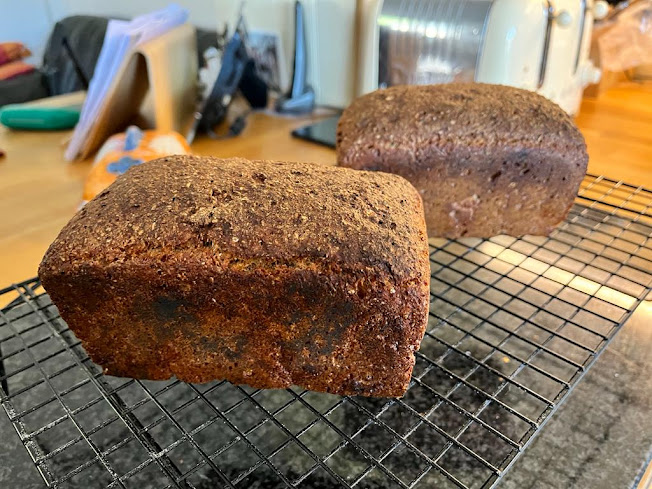The Ballymaloe Wholemeal Loaf (The 'Grant Loaf')
Welcome to another step-by-step recipe from BreadClub20. Why not drop by our main Facebook page by clicking here.... If you like what you see and enjoy the recipe, we hope you go on to join us by 'Liking' and 'Subscribing'.
If there was ever a bread that would be eligible for PGI status (Protected Geographical Indication), then it should be the 'Grant Loaf' that was later refined at Ballymaloe in County Cork, Ireland.
There's an important part of our social history tied up in the 'Grant Loaf'
And first, we have to step back in time to the 1940s.
Doris gave her name to the 'Grant Loaf' a no-knead wholemeal loaf, invented purely by accident. She had added the yeast, but forgot to knead the dough. After baking, she felt that the taste was superior to all her previous efforts.
.jpeg) |
| Doris Grant |
But what, I hear you ask, has this to do with Ballymaloe?
We now need to meet Myrtle Allen, founder of Ballymaloe House, a hotel and cookery school in County Cork, Ireland.
Myrtle Allen (1924 - 2018) was an Irish, Michelin star-winning Head Chef and Hotel owner. In her lifetime, she became fascinated with the history of food, in general, and in Doris Grant's work, in particular.
Freed from the privations of war-time Britain, she revisited many of Grant's recipes and it's her version of the Grant Loaf that we are baking today.
INGREDIENTS
500 gms wholemeal bread flour
400 gms tepid water
1¼ teaspoon crushed sea salt
1 teaspoon black treacle or molasses (it's easier if you put a hot wet spoon into the treacle)
3½ teaspoon dried yeast (or 1¼ teaspoon instant active yeast)
METHOD
The recipe below mentions that the water and the flour should be 'warm'. What do we mean by warm? 22⁰ C - 24⁰C would be fine.
Grease 2lb or 2 x 1lb loaf tin(s) and warm in in a 100⁰C oven for 10 minutes
Add a little of the warm water to the yeast and stir. Leave covered for 5 minutes. Add the treacle, stir and leave for a further 10 minutes. By now, it should be frothy.
Add the remaining water and stir.
Warm the flour for 10 minutes so that it is comfortably warm - like a warm duvet.
Mix the flour and the salt in a large bowl. Make a well in the centre and pour in the yeasted mixture.
Bring in the flour from the sides and incorporate all the ingredients until you have a thick batter.
Using a spurtle, Dutch whisk or your hands, bring the dough together for about one minute until you form a soft, sticky dough.
Put the dough in the loaf tin, cover and place somewhere warm for about 60 minutes or so (it's dependent on the warmth and the yeast - so watch the dough, not the clock) until the dough has risen to within a half inch of the top of the tin. It won't rise much above the top of the tin, so don't stop the process too early.
Meanwhile, preheat your oven to 220⁰C.
Bake for 30 minutes and then lower the heat to 200⁰C for a further 15 minutes.
Turn the loaf out onto a cooling rack and allow to cool.
POSTSCRIPT
The ORIGINAL Grant Loaf called for :
450 gms of strong wholemeal flour (spelt works just as well) slightly warm
1 teaspoon Muscovado sugar (or honey)
2 teaspoons salt
400 - 450 gms hand-hot water
Fresh or dried yeast (or 7 gms instant yeast)
The method involved mixing the dry ingredients and then add the water. Mixed together, it becomes quite a wet mix.
Tip out onto a floured board and then stretch out into a rectangle. Carry out a letter box fold until you have a shape in line with your well-greased loaf tin.
Leave in a warm place to rise for an hour and then bake for 30 - 40 minutes until baked and hollow when tapped underneath. Take out of tin and continue to bake for 5 - 10 minutes and then cool on a rack. The oven should be set at 200⁰C.









Comments
Post a Comment